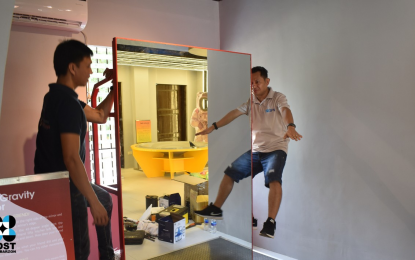
ANTI-GRAVITY MIRROR. One of the exhibits at the Department of Science and Technology's (DOST) Mini Science Centrum on Alabat Island shows the reflection of a man seemingly floating in this undated photo. The DOST, in collaboration with the Department of Education and the Quezon provincial government, has completed construction of the S&T facility that is expected to fully open to the public in April 2024. (Photo courtesy of DOST)
CALAMBA CITY, Laguna – The Department of Science and Technology (DOST) in Quezon province has completed the construction of the Mini Science Centrum on Alabat Island to enhance learning and encourage the local youth, some of whom are members of Indigenous Peoples (IP) communities, to take up careers in science and technology (S&T).
The center includes interactive exhibits that highlight cause-and-effect relationships, allowing youthful visitors to learn about scientific concepts by participating in experiments.
In an interview on Wednesday, Aldwin Royena, a science research analyst at DOST-Quezon, said the department’s Community Empowerment through Science and Technology (CEST) Program established the science centrum at Cesar C. Tan Memorial National High School and also put up all the S&T exhibits on display.
An exhibit that is expected to catch the public’s attention is the “Gravity Mirror,” which appears as an ordinary mirror except the reflection shows people mysteriously suspended in midair.
“The mini science centrum aims to showcase interactive and unique exhibits on science concepts and processes that would help teachers and learners in the said island communities,” Royena said.
He said the facility's objective is to satisfy the scientific curiosities of youths in the island’s three municipalities – Perez, Quezon and Alabat.
The DOST Region IV-A (Calabarzon), Philippine Foundation for Science and Technology (PFST), Department of Education (DepEd), Quezon town local government unit (LGU) and Quezon provincial government collaborated for the project, which will become fully operational in April.
Alabat Island has an area of 192 square kilometres and a population of some 44,000 based on the latest survey.
It is also home to the Alabat Agta people, who speak an indigenous language called Inagta Alabat, which the United Nations Educational, Scientific and Cultural Organization (UNESCO) declared a "critically endangered language" as it is seen to disappear in 30 years. (PNA)
